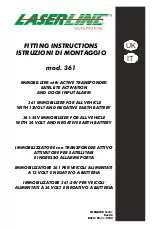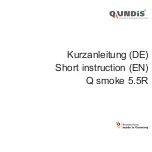
ICAM by Xtralis
ICAM Commissioning Guide
www.xtralis.com
15
5
System Integrity Test
ICAM systems can be tested in a number of different ways. Most sites will require different types of testing for
different customer environments. Before conducting smoke tests you must check to see if the local codes
and standards specify which type of smoke test is to be performed. Local codes and standards may also
require changes to the general instructions below, where local codes and standards are different to the ICAM
suggestions, ALWAYS follow the local codes and standards.
Performance testing is done during commissioning and may be required during service, but is not essential.
We highly recommend pipe integrity testing be performed each year.
Note:
Some tests create a large amount of smoke, so you should take the necessary precautions before you
begin testing.
5.1
Performance-based Smoke Testing
A smoke test is necessary to prove the integrity of the pipe network and to measure the response time. The
type of smoke test required will depend upon the site and the application:
l
Warehouses and open areas can use either a smoke pellet test, a polyurethane mat test, or possibly a
wooden block test. Please check with the local codes and standards to find the most appropriate type of
test for the environment.
l
Very sensitive sites can use the electrical overload (PVC coated wire burn test), or the smouldering test
coil test. (UK customers can refer to BS 6266, BFPSA Code of Practice Appendix A for system
performance test methods).
We recommend that at least two tests are conducted. You must allow the environment to return to the normal
conditions before beginning the second test.
Record the date and the type of smoke test used on the commissioning or testing forms. Please re-read the
detector manuals if you are unsure of how to interpret smoke levels, Alert, Alarm or Fire1.
At a minimum, testing requires that you conduct pipe integrity smoke testing.
5.1.1
Testing and Stratification Problems
In areas with a high roof you can expect the air temperature near the roof to be warmer than the air temperature
at ground level. This can cause the stratification of smoke. Stratification occurs when warm smoke rises until
it reaches a layer of air with the same temperature and then stops rising. This may cause problems as the
smoke may not reach sample points which are mounted on the roof.
As the height of the roof increase you will need a larger distance between the roof and the sampling point to
continue correctly sampling the air. Heights up to 3 m (9 ft) can use standard 25 mm (1 in.) standoffs.
Roof Height (M)
1
2
3
4
5
6
7
8
9
Distance from roof (mm)
30
30
30
100
200
300
400
500
600
For testing purposes you can use a 5.8 kW gas burner or electric heater to add heat to the smoke to make sure
it will reach the roof.








































